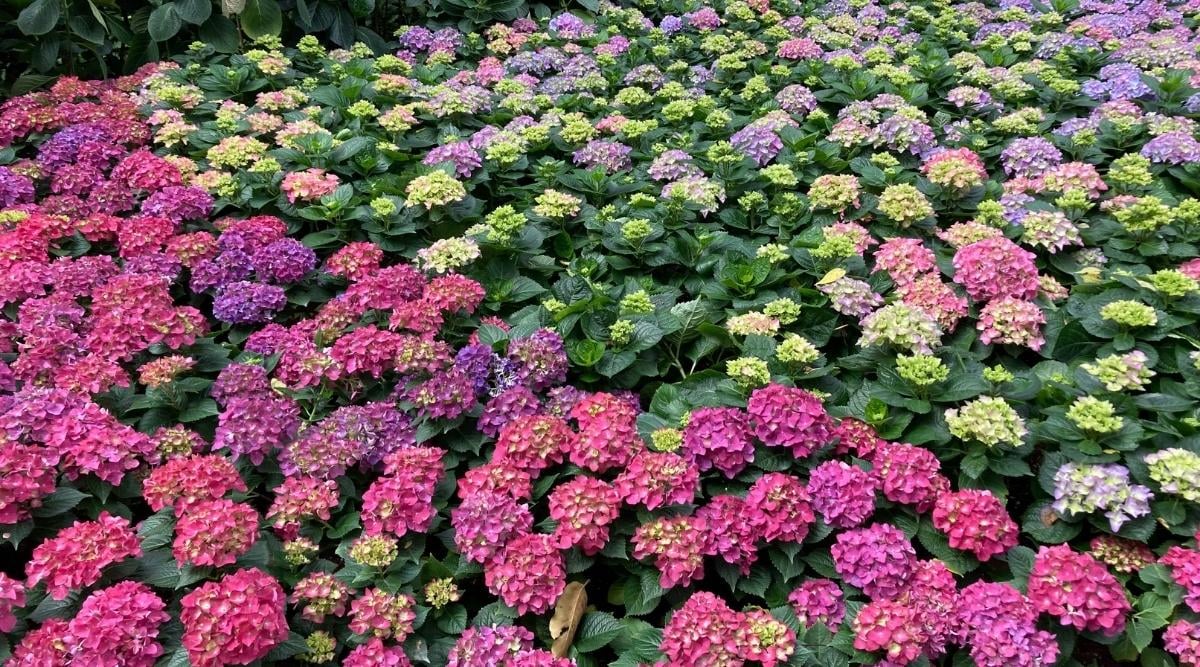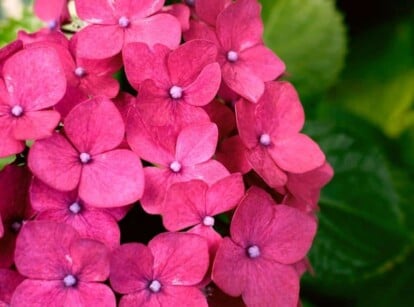Can You Grow Hydrangeas in Hardiness Zone 8?
Do you live in hardiness zone 8, but aren't quite sure if hydrangeas will thrive in your climate? Hydrangeas are gorgeous shrubs, but they typically grow the best in the right environment. In this article, gardening expert Jill Drago examines what you can expect when growing hydrangeas USDA hardiness zone 8.

Contents
Hydrangeas are a classic plant in the Northern United States but it is also a southern favorite. From their big beautiful blooms, to unique blue varieties, these flowering shrubs are garden pleasers. They are easy to grow, and are fairly low maintenance when compared to other garden shrubs. But will they grow in USDA hardiness zone 8?
If you live in one of the areas of the United States that falls into USDA hardiness zone 8, you may be curious to know if it’s wise to grow hydrangeas in your geographic location. While the easy answer is “yes” hydrangeas can grow here, the full answer is a bit more nuanced than that.
Hydrangeas are known for their hardiness in northern climates, mainly their ability to withstand harsh winters. But certain varieties actually love the sun, and can do well in warmer climates. Let’s take a look a little deeper into if you should be planting them, and what you can expect in zone 8!
The Short Answer
The short answer is, yes, hydrangeas can be grown in USDA hardiness zone 8.Hydrangea quercifolia and Hydrangea arborescens are native to zone 8, making them perfect choices for your garden. However, even the ever-popular bigleaf hydrangea (Hydrangea macrophylla) is tolerant of the climate found in zone 8.
What is Zone 8?

Zone 8 is made up of the Pacific Northwest and a pretty good chunk of the South. These regions have comfortably warm summers with cool nights and mild winters giving you a nice long growing season. The lowest average temperatures in these areas are between 10 and 20 degrees.
Best Zone 8 Varieties
It will be easy for you to find the right hydrangea for your zone 8 garden since so many of them are hardy up to zone 9. There are many varieties of hydrangea that will do well in zone 8, these are just a few options to get your creativity started!
Hydrangea arborescens ‘Annabelle’

Hydrangea arborescens, or the smooth hydrangea, is native to the Eastern United States. The flowers on ‘Annabelle’ can reach up to 12 inches across! The blooms appear in late spring and will often continue into the fall. This plant will reach five feet tall and wide, but be sure to give it lots of room to grow so the large flowers have enough room to droop, which they might do after heavy rain.
Hydrangea macrophylla ‘Pia’

This is a dwarf hydrangea with mophead blooms that measure about four inches across. These flowers are purple or pink. Unlike other bigleaf hydrangeas ‘Pia’ is not affected by your soil pH, and the flowers will remain pink. ‘Pia’ is slow-growing and will top out at two to three feet in height and width. The leaves are dark green and glossy. This plant is hardy in zones 5-9.
Hydrangea macrophylla ‘Variegata’

This is a really pretty variety of hydrangea. The flowers are lacecap in a pale blue or pink. The best part of this plant is its variegated leaves. The leaves are green with a white edge, painting an almost watercolor picture in your garden.
The lacecap flowers are delicate and complement the leaves perfectly. Plant this beauty in partial sun and it will reach six feet in height. Perfect for zone 8 as it is hardy in zones 6-9.
Hydrangea paniculata ‘Burgundy lace’

This is a rapid grower that bears eight-inch cone-shaped creamy flowers in the summer, which later turn burgundy in the fall. Ornate oak leaf-shaped leaves offer a different texture to your garden.
The leaves will also turn a shade of orange or red in the fall adding to your autumn color. Reaching six feet in height and width this plant requires morning sun and dappled afternoon shade. Very tolerant of cold and heat, ‘Burgundy Lace’ is hardy from zones 4-9!
Hydrangea quercifolia ‘Snowflake’

This variety of hydrangea has really interesting flowers, made up of clusters of white flowers that will remind you of a snowflake, even on the hottest summer day. This shrub is native to the zone 8 region making it a perfect selection for your garden.
‘Snowflake’ has a little more of a wild growth habit than some of the other hydrangeas we typically see. This growth habit makes it a fun choice for a woodland edge mixed in with other native perennials. Growing from four to six feet tall you could also use this as a border or a hedge to hide a fence or maybe an air conditioner unit in your yard.
Planting in Zone 8
So you’ve decided to plant hydrangea in zone 8. Great decision! If you need a full guide on getting started, check out our comprehensive guide to hydrangea care. But for a good quick overview on what to do in zone 8, keep on reading!
Planting

The best time to plant hydrangeas in zone 8 is in the fall or the spring. The planting method is fairly similar if you are container planting your hydrangea, or planting in the ground. Once you have selected the right place for your plant, dig a hole twice as deep as the container your plant is in. Dig a little deeper than the pot, but not too much deeper as you don’t want to bury the base of the plant.
If you have clay, or sandy soil you will want to amend it with some organic material, such as compost or peat. Once you have replaced the soil around the newly planted hydrangea, water the plant until the water starts to puddle on the top of the soil. Once that water is absorbed, give it just a little bit more.
Light

Be sure to situate your hydrangea in partial sun. Morning sun and afternoon shade is preferable. If you are able to, plant your hydrangea on the North side of your home ensuring it receives enough sun and shade to thrive in your garden. Since most zone 8 gardens are going to be sunny, you’ll need to keep your hydrangea’s location in mind before planting.
Watering

Hydrangea leaves are known to wilt when they are getting too much direct sunshine, or the heat is intense for longer periods of time. Regular watering, weekly or more often, will aid in keeping your plants hydrated. Some zone 8 gardens are going to be a bit different than others, as the southeastern US gets quite a bit more rain than the southwest. So stay mindful, and make sure your hydrangeas aren’t getting soaked.
Avoid overhead watering. If you are watering by hand, do your best to keep the hose aimed at the base of the plant and the surrounding area. Water that sits on the leaves and flowers can lead to diseases.
Fertilizing

Hydrangeas benefit from an all-purpose tree and shrub fertilizer a few times a year. It is important, however, not to fertilize after the end of the summer. Stick to fertilizing in the spring or in the fall.
The plant will already be preparing to go dormant and too much fertilizer at this point will force the plant to produce new growth and flower blooms which will end up damaged over the winter.
Color Control

Depending on where you live in zone 8, your hydrangea colors can be controlled by the pH levels of the soil. Specifically, the flowers of bigleaf hydrangea can be quite sensitive (not H.macrophylla ‘Pia’ though!).
You can enhance the colors of your flowers by adding aluminum sulfate for blue flowers, or lime for pink and red flowers. It should be noted that these additives will only enhance or correct the color of the flowers. Soils that are more on the acidic side, below 5.5 pH, will favor blue flowers by allowing the hydrangea to absorb more aluminum. Whereas soils that are above 6.5 pH, or “sweet” soils, will produce pink flowers on your hydrangea.
Before amending your soil with anything a soil test is recommended. There are soil test kits available at hardware stores and garden centers. However, if you have a local college or university with an agricultural extension office they will do a more extensive test for you. This is important given that not all soil types are the same across zone 8.
Final Thoughts
Hydrangeas for everyone! As long as you can give your plants a break from the sun and plenty of water you are bound to have beautiful success on your hands! Add a few hydrangeas to your zone 8 garden to give it a cottage feel, create an abundantly blossoming hedge or a really sweet border along your white picket fence.









